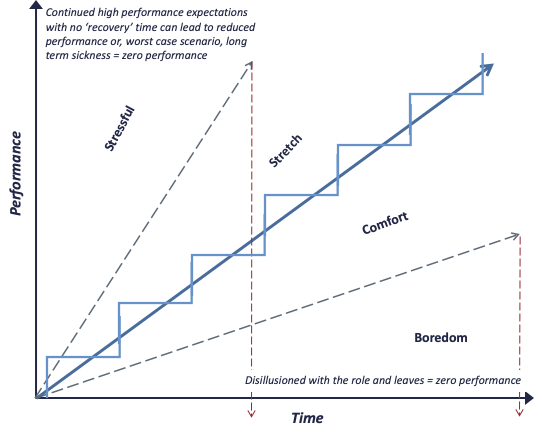Cultural change is the hardest part of digital transformation. Many organisations try to create a working environment that reflects their values, which usually requires significant employee engagement to create an emotional commitment to the organisation, and to its success. In Cultural Change and Employee Engagement, we concluded that Cultural Change = Employee Engagement.
It is generally accepted that a company should invest time and money in its staff - after all, they are the company.
But, wouldn't it be great if the payback on that spend could be quantified, so that those Execs who were unwilling to sanction investment had the confidence that it was money well spent?
Let's start with employee performance, and not necessarily the HR type of performance that is judged on meeting targets set during an appraisal, but something a bit more holistic.
P = A x M x O x D
Performance = Ability x Motivation x Opportunity x Direction
We all want the same things when at work - to know what we need to do, to know how well to do it and to feel as though we fit in. Whether we are an employee or senior leader we all want to:
- work with a compelling and clear sense of purpose
- have a sense that we are a master of the work we do
- be allowed to perform to our potential
- work with colleagues who always strive to do their best
- work in a place where each person's contribution is valued
- be well led
- be proud of being part of a successful and visionary organisation.
An individual's Performance is driven by having the Ability to do their work (training and enough time to complete tasks); an enjoyment of the work itself and/or the desire to achieve certain goals, either or both of which underpin personal Motivation; being encouraged to be self-directing enough to plan and set direction which gives Opportunity to succeed to their own terms; to know Why their company is in business, beyond what they themselves do, KPIs and profit - a Direction set by energising leaders.
How often have you visited a business and thought 'I'd like to work here'?
You can sense the energy, commitment and pride of a highly productive culture. It's threaded through employee involvement and extends into the customer experience. Technology and processes are aligned; leaders lead; staff are empowered; customers become advocates.
This culture can't be copied - culture is a competitive advantage.
Highly productive cultures don't just happen by accident. There is strong correlation between high productivity and the level of employee engagement, which is consistent across sectors.
A country's productivity is closely linked with its living standards, whereas for a company it is directly tied to performance. Productivity is about doing more with the same. With higher productivity, a company can produce more goods and services with the same amount of relative work. That outcome can be quantified.
The more effort a company puts into engagement and managing employee performance the better the performance. Increased performance leads to increased productivity, and that improves the bottom line.
Managing Performance
When leaders are creating a culture of performance they need to keep an eye on their teams and individuals to make sure that they stay in the optimum performance zone.

Too much expectation can cause exhaustion and stress, which can lead to long-term sickness or exiting the organisation. Similarly, a lack of involvement leads to dis-engagement and boredom - with a similar outcome - they leave.
The ideal mix is periods of stretch followed by periods of comfort to embed learning to allow people to ‘catch their breath’.
Failure to manage performance can lead to a resignation, and the cost of losing the knowledge of that individual, and fees to recruit someone new. Well managed performance, where staff are sufficiently engaged and supported to stretch themselves can significantly contribute to improved company financial performance.
Engagement
71% of leaders say that engagement is critical to their success, according to FastTrack360. It varies by year, but Gallup says that just 13-18% of employees are engaged at work. Some source says that the figure is even lower in the UK, may be as low as 11%.
Gallup also says that two-thirds of employees feel no meaningful attachment to the company and their job. Worse, 20-25% are actively disengaged, and busy acting out their discontentment, undermining what their colleagues achieve.
Actively disengaged staff have a huge impact on profitability.
Retention. Disengaged employees are likely to want to find a job that interests them, probably in another organisation. This affects employee retention. Engaged employees are 85% percent more likely to stay with their employer. Employee engagement is a major reason why employees leave an organisation, wasting the investment in that person and the new cost of a replacement.
Customer Experience. An important part of the reason why customers do business with companies is based on the level of service they receive. In a customer-centric organisation the impact of a disgruntled employee is significant. Two-thirds of customers won't return after a poor experience, and the disengaged representative will rarely own the customer's problem. Customers need to know that the representative is empowered to resolve the problem, influencing the customer's emotional connection along the way.
Productivity. Some research notes that disengaged employees make 100 times more errors than their engaged colleagues – this is a lot of productivity lost through rework, never mind errors that have bigger consequences. They also tend take time out to check Facebook, take a break and chat. When disengaged employees call in sick, not only is their theoretical work capacity lost, but their engaged colleagues must pick up the slack. Some research puts the cost to the company of an actively disengaged employee at one-third of their salary - £10,000 for someone making £30,000 per year.
Profitability. The three categories above all contribute to unnecessary cost or loss of opportunity. Worse, studies have shown that companies with the 'average' level of disengaged staff have a revenue which is reduced by 33% of comparable organisations with much higher engagement.
The message is clear, highly engaged cultures become more performant, engender behaviours that please the customers and grow both the size of the business and its profitability. 70% of buying experiences are based on how the customer feels they are being treated, and people tend to buy from people they like, even if that acquaintance is fleeting. And the effect is perpetuating, a virtuous spiral of improvement.
Conversely, actively disengaged staff have a toxic effort on performance, out of step with their own personal sense of injustice, disinterest or boredom. One disgruntled action can have an impact well beyond its initial cost. Their lack of commitment sucks the energy from those who need to compensate, even if they don't realise it.
Benefit Calculation
With more time, a more detailed Business Case could be produced, with multiple items contributing to cost saving, cost avoidance and risk mitigation set out.
But a simple calculation is all that is needed. Taking the figures in the narrative above, let's assume that your organisation has only 20% actively disengaged staff, and a slightly lower than normal productivity loss of 30% due to active and passive disengagement:

For a medium size company of 1000 employees each being paid an average UK salary of £30,000 pa, that results in a £2m loss, every year.
The cost of an employee engagement initiative and some digital tooling won't cost anywhere near this amount, so return on investment will be rapid.
This is a quantitative benefit. But the qualitative benefits are just as important. Front of mind is the pleasure for everyone of working in a well-run company, where there is certainty of organisational purpose, a happy and motivated workforce, an emotional connection with customers, and where the fruits of collective labour are proportionally rewarded.
Two-thirds of staff say that they would take a pay cut to work for an organisation that offers them a better culture fit.
Our aim must be an innovative, resilient, and unified workforce where the collective talent of the teams in the value chain is leveraged, and the majority of employees feel as though they are a valued part of the wider team.
The bottom line?
Employee Engagement = Productivity = Profits
Time and money spend on employee engagement is repaid many times over.
Next:
We touched on Autonomy, Mastery and Purpose at the start of the this article. There is more to share.


